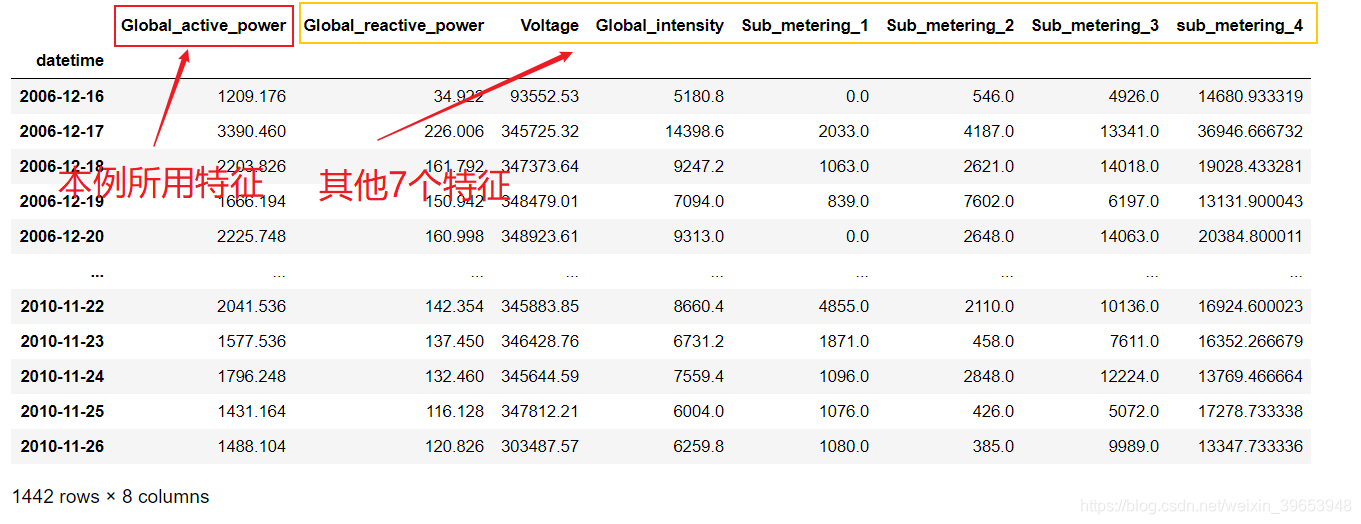接上文,本文介绍了ConvLSTM模型实现用电量/发电量预测。
LSTM 处理用电量/发电量预测任务的文章:
【Part1】Encoder-Decoder LSTM 模型 实现用电量/发电量预测
【Part2】CNN-LSTM 模型 实现用电量/发电量预测
【Part3】本文
文章目录
1. ConvLSTM
1.1 CNN 模型
CNN-LSTM方法的进一步扩展是执行CNN的卷积(例如CNN如何读取输入序列数据)作为LSTM的一部分用于每个时间步。这种组合称为ConvLSTM,与CNN-LSTM一样,它也用于时空数据。与直接读取数据以计算内部状态和状态转换的LSTM不同,与解释CNN模型输出的CNN-LSTM也不同,ConvLSTM直接使用卷积作为读取LSTM单元输入的一部分。Keras库提供了ConvLSTM2D类,该类支持二维数据的ConvLSTM模型。它可以配置为一维多变量时间序列预测。默认情况下,ConvLSTM2D类要求输入数据的形状为:[samples,timesteps,rows,cols,channels]。
其中数据的每个时间步均定义为(行×列)数据点的图像。我们正在处理总功耗的一维序列,如果我们假设我们使用两周的数据作为输入,则行为1,列为14。ConvLSTM将一次读取这些数据,即LSTM读取一个14天的时间步长,并在这些时间步长上进行卷积。
在我们的任务中,可以将14天分成两个子序列,每个子序列的长度为7天。然后,ConvLSTM可以读取两个时间步长,并对每个时间步长中的7天数据执行CNN处理。因此,对于此问题的选定框架,ConvLSTM2D的输入shape为:[n,2,1,7,1]。参数说明:
- 样本(samples):n,表示训练数据集中的样本数。
- 时间步长(timesteps):2,表示将一个窗口宽度为14天的采样数据分为两个子序列。
- 行(rows):1,表示每个子序列的一维形状,即有多少行。
- 列(cols):7,表示每个子序列,有多少列。
- 通道(channels):1,在图像识别任务中的概念,通道数。在时间序列预测任务中其实就是特征数(features),这个概念在之前的文章中反复提及强调。因为本例的业务需求是通过日总功耗来预测下周的日总功耗,所以通道数(特征数)为1,即代表日总功耗。如果要添加其他的特征,这个尺寸要做相应改变。再看下数据集情况,就一目了然了。

还可以探索其他配置,例如使用前21天的总功耗作为输入,并将其分为3个子序列,和/或提供所有八个功能或通道作为输入。ConvLSTM2D的数据输入要求必须将训练数据集重塑为[样本,时间步长,行,列,通道]([samples, timesteps, rows, cols, channels])的结构。对比CNN-LSTM完整代码,需要在此基础上做如下修改:
1. 重塑训练样本的shape:
train_x = train_x.reshape((train_x.shape[0], n_steps, 1, n_length, n_features))
2. 设定ConvLSTM模型的输入尺寸参数:
model.add(ConvLSTM2D(filters=64, kernel_size=(1,3), activation='relu',input_shape=(sw_width, 1, n_length, n_features)))
model.add(Flatten())
3. 重塑测试样本的shape:
input_x = input_x.reshape((1, sw_width, 1, n_length, 1))
1.2 完整代码
import numpy as np
import pandas as pd
import matplotlib.pyplot as plt
# 设置中文显示
plt.rcParams['font.sans-serif'] = ['Microsoft JhengHei']
plt.rcParams['axes.unicode_minus'] = False
import math
import sklearn.metrics as skm
from tensorflow.keras.models import Sequential
from tensorflow.keras.layers import LSTM, Dense
from tensorflow.keras.layers import RepeatVector, TimeDistributed
from tensorflow.keras.layers import ConvLSTM2D
def split_dataset(data):
'''
该函数实现以周为单位切分训练数据和测试数据
'''
# data为按天的耗电量统计数据,shape为(1442, 8)
# 测试集取最后一年的46周(322天)数据,剩下的159周(1113天)数据为训练集,以下的切片实现此功能。
train, test = data[1:-328], data[-328:-6]
train = np.array(np.split(train, len(train)/7)) # 将数据划分为按周为单位的数据
test = np.array(np.split(test, len(test)/7))
return train, test
def evaluate_forecasts(actual, predicted):
'''
该函数实现根据预期值评估一个或多个周预测损失
思路:统计所有单日预测的 RMSE
'''
scores = list()
for i in range(actual.shape[1]):
mse = skm.mean_squared_error(actual[:, i], predicted[:, i])
rmse = math.sqrt(mse)
scores.append(rmse)
s = 0 # 计算总的 RMSE
for row in range(actual.shape[0]):
for col in range(actual.shape[1]):
s += (actual[row, col] - predicted[row, col]) ** 2
score = math.sqrt(s / (actual.shape[0] * actual.shape[1]))
print('actual.shape[0]:{}, actual.shape[1]:{}'.format(actual.shape[0], actual.shape[1]))
return score, scores
def summarize_scores(name, score, scores):
s_scores = ', '.join(['%.1f' % s for s in scores])
print('%s: [%.3f] %s\n' % (name, score, s_scores))
def sliding_window(train, sw_width=7, n_out=7, in_start=0):
'''
该函数实现窗口宽度为7、滑动步长为1的滑动窗口截取序列数据
'''
data = train.reshape((train.shape[0] * train.shape[1], train.shape[2])) # 将以周为单位的样本展平为以天为单位的序列
X, y = [], []
for _ in range(len(data)):
in_end = in_start + sw_width
out_end = in_end + n_out
# 保证截取样本完整,最大元素索引不超过原序列索引,则截取数据;否则丢弃该样本
if out_end < len(data):
# 训练数据以滑动步长1截取
train_seq = data[in_start:in_end, 0]
train_seq = train_seq.reshape((len(train_seq), 1))
X.append(train_seq)
y.append(data[in_end:out_end, 0])
in_start += 1
return np.array(X), np.array(y)
def conv_lstm_model(train, sw_width, n_steps, n_length, in_start=0, verbose_set=0, epochs_num=20, batch_size_set=4):
'''
该函数定义 Encoder-Decoder LSTM 模型
'''
train_x, train_y = sliding_window(train, sw_width, in_start=0)
n_timesteps, n_features, n_outputs = train_x.shape[1], train_x.shape[2], train_y.shape[1]
train_x = train_x.reshape((train_x.shape[0], n_steps, 1, n_length, n_features))
train_y = train_y.reshape((train_y.shape[0], train_y.shape[1], 1))
model = Sequential()
model.add(ConvLSTM2D(filters=64, kernel_size=(1,3), activation='relu',
input_shape=(n_steps, 1, n_length, n_features)))
model.add(Flatten())
model.add(RepeatVector(n_outputs))
model.add(LSTM(200, activation='relu', return_sequences=True))
model.add(TimeDistributed(Dense(100, activation='relu')))
model.add(TimeDistributed(Dense(1)))
model.compile(loss='mse', optimizer='adam', metrics=['accuracy'])
print(model.summary())
model.fit(train_x, train_y,
epochs=epochs_num, batch_size=batch_size_set, verbose=verbose_set)
return model
def forecast(model, pred_seq, sw_width, n_length, n_steps):
'''
该函数实现对输入数据的预测
'''
data = np.array(pred_seq)
data = data.reshape((data.shape[0]*data.shape[1], data.shape[2]))
input_x = data[-sw_width:, 0] # 获取输入数据的最后一周的数据
input_x = input_x.reshape((1, n_steps, 1, n_length, 1))
yhat = model.predict(input_x, verbose=0) # 预测下周数据
yhat = yhat[0] # 获取预测向量
return yhat
def evaluate_model(model, train, test, sd_width, n_length, n_steps):
'''
该函数实现模型评估
'''
history_fore = [x for x in train]
predictions = list() # 用于保存每周的前向验证结果;
for i in range(len(test)):
yhat_sequence = forecast(model, history_fore, sd_width, n_length, n_steps) # 预测下周的数据
predictions.append(yhat_sequence) # 保存预测结果
history_fore.append(test[i, :]) # 得到真实的观察结果并添加到历史中以预测下周
predictions = np.array(predictions) # 评估一周中每天的预测结果
score, scores = evaluate_forecasts(test[:, :, 0], predictions)
return score, scores
def model_plot(score, scores, days, name):
'''
该函数实现绘制RMSE曲线图
'''
plt.figure(figsize=(8,6), dpi=150)
plt.plot(days, scores, marker='o', label=name)
plt.grid(linestyle='--', alpha=0.5)
plt.ylabel(r'$RMSE$', size=15)
plt.title('Conv-LSTM 模型预测结果', size=18)
plt.legend()
plt.show()
def main_run(dataset, sw_width, days, name, in_start, verbose, epochs, batch_size, n_steps, n_length):
'''
主函数:数据处理、模型训练流程
'''
# 划分训练集和测试集
train, test = split_dataset(dataset.values)
# 训练模型
model = conv_lstm_model(train, sw_width, n_steps, n_length, in_start, verbose_set=0, epochs_num=20, batch_size_set=4)
# 计算RMSE
score, scores = evaluate_model(model, train, test, sw_width, n_length, n_steps)
# 打印分数
summarize_scores(name, score, scores)
# 绘图
model_plot(score, scores, days, name)
print('------头发不够,帽子来凑-----')
if __name__ == '__main__':
dataset = pd.read_csv('household_power_consumption_days.csv', header=0,
infer_datetime_format=True, engine='c',
parse_dates=['datetime'], index_col=['datetime'])
days = ['sun', 'mon', 'tue', 'wed', 'thr', 'fri', 'sat']
name = 'Conv-LSTM'
# 定义序列的数量和长度
'''
n_steps:子序列划分的数量,本例为2,将14天的数据划分为两个7的子序列;
n_length:子序列每行的元素数,即列数。
'''
n_steps, n_length = 2, 7
sliding_window_width= n_length * n_steps
input_sequence_start=0
epochs_num=20
batch_size_set=16
verbose_set=0
main_run(dataset, sliding_window_width, days, name, input_sequence_start,
verbose_set, epochs_num, batch_size_set, n_steps, n_length)
输出:
Model: "sequential_12"
_________________________________________________________________
Layer (type) Output Shape Param #
=================================================================
conv_lst_m2d_2 (ConvLSTM2D) (None, 1, 5, 64) 50176
_________________________________________________________________
flatten_3 (Flatten) (None, 320) 0
_________________________________________________________________
repeat_vector_8 (RepeatVecto (None, 7, 320) 0
_________________________________________________________________
lstm_16 (LSTM) (None, 7, 200) 416800
_________________________________________________________________
time_distributed_16 (TimeDis (None, 7, 100) 20100
_________________________________________________________________
time_distributed_17 (TimeDis (None, 7, 1) 101
=================================================================
Total params: 487,177
Trainable params: 487,177
Non-trainable params: 0
_________________________________________________________________
None
actual.shape[0]:46, actual.shape[1]:7
Conv-LSTM: [382.156] 391.3, 386.4, 340.5, 388.9, 364.4, 309.1, 473.6
运行示例总结测试集的性能。实验表明,使用两个卷积层使模型比仅使用单个层更稳定。可以看到,在这种情况下,该模型表现较好,总体RMSE得分约为382千瓦。
扩展
- 输入大小:探索模型的输入天数,例如3天,21天,30天等等。
- 模型调整:调整模型的结构和超参数,并进一步提升模型性能。
- 数据缩放:探索是否可以使用数据缩放(例如标准化和规范化)来改善LSTM模型的性能。
- 学习诊断:使用诊断(例如训练的学习曲线和验证损失以及均方误差)来帮助调整LSTM模型的结构和超参数。
总结
三篇文章介绍了如何开发LSTM来进行家庭用电量的多步时间序列预测。主要有以下内容:
- 如何开发和评估用于多步时间序列预测的单变量和多变量Encoder-Decoder LSTM 模型。
- 如何开发和评估用于多步时间序列预测的CNN-LSTM Encoder-Decoder 模型。
- 如何开发和评估用于多步时间序列预测的ConvLSTM Encoder-Decoder 模型。
关于时间序列预测用电量预测任务先告一段落,下篇文章开始介绍时间序列分类任务,比如人类行为识别,车辆驾驶行为识别。
